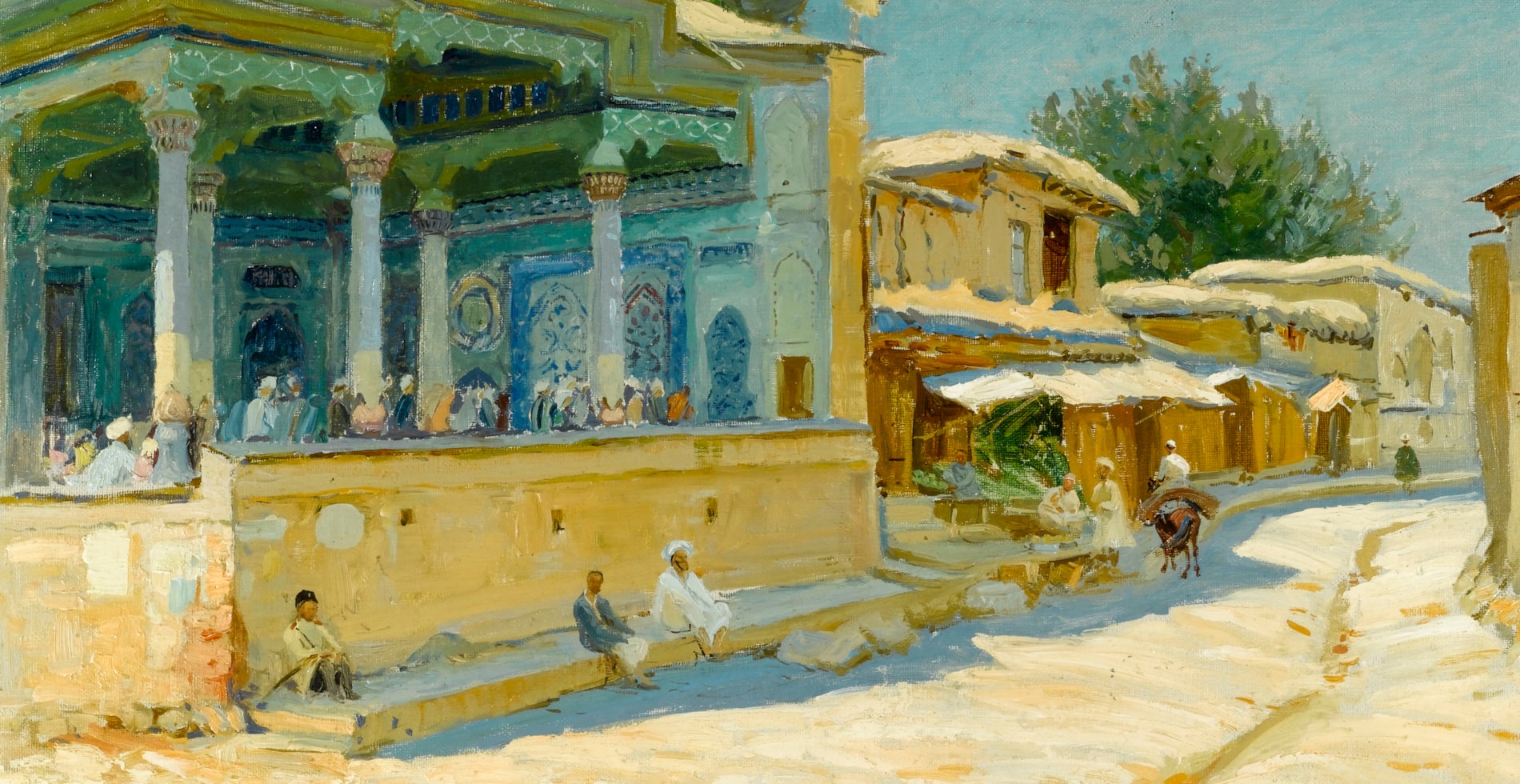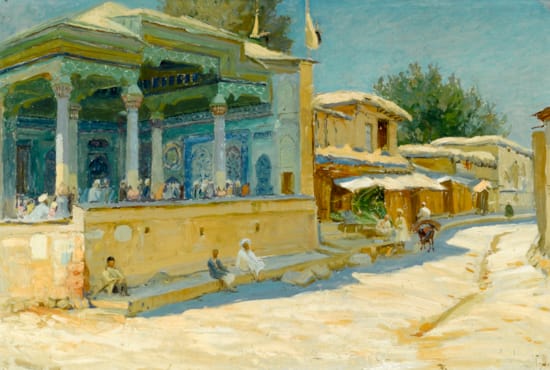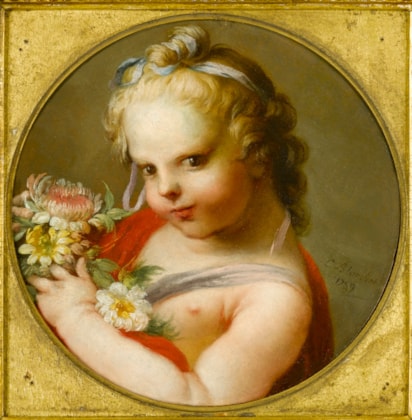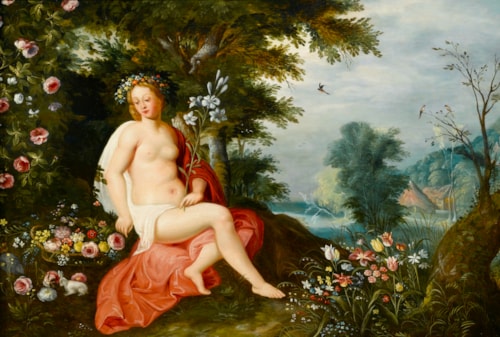enrikh Genrikhovich Schmidt
(German 1861 - 1922)
Outside the Mosque
oil on canvas board
signed (lower right)
45 x 67.5 cm (17¾ x 26½ in)
In Outside the mosque Genrikh Schmidt portrays a mosque filled with waiting worshippers. The architectural style of the mosque is Arab-plan or hypostyle, which was the earliest type of mosque first adopted by the Umayyad Dynasty (661-750). It is called hypostyle on account of its square or rectangular plan with an enclosed courtyard or portico and, though hidden in the present work, a covered prayer hall. Historically, in the warm Mediterranean and Middle Eastern climates, the courtyard served to accommodate the large number of worshippers present during Friday prayers. Most early hypostyle mosques had flat roofs in the prayer halls, which required the use of numerous columns and supports.
The open portico fronting the mosque is very similar to an iwan, which is a vaulted hall or space, walled on three sides and with one end entirely open. Iwans were a trademark of the Sassanid architecture of Persia and were later absorbed into Islamic architecture. In the present work the portico’s ceiling is coffered and highly decorated, in particular one can see vibrant blue and gold decoration in the central raised section of the roof. The structure is supported by five or possibly six columns, whilst the capitols are scalloped and painted - an evolution from an earlier classical prototype. Though on a much larger and grander scale, the Bolo-Hauz mosque in Bukhara, Uzbekistan, displays a similarly coffered and decorated iwan at the entrance to the mosque.
Inside the mosque there are a sizeable number of worshippers standing around in the portico. From the limited shadow coverage that falls on the road outside, it is most probably the mid-day prayer calling. The road flanking the mosque is empty apart from a few lone figures who are seated in the welcome shade offered by the building. Sitting up against a high wall, the viewer is particularly drawn to the seated figure on the left. Set apart from the other two resting figures on the curb side, he is dressed in military uniform and his solitude is especially poignant. Though the location of the work is unknown, it could be in Central Asia, and the lone soldier is either a member of a local militia or Russian Imperial army posted to the region. The rest of the road is emptied of pedestrians and all the shop fronts are closed apart from a single grocer who continues with his business. Under an awning, a stall selling vegetables has attracted a pair of customers, whilst a laden donkey makes its way towards them.
Schmidt’s work is similar to that of his contemporary Richard Karlovich Zommer, both in terms of painting style and subject matter. Schmidt, like Zommer, chose to capture locations that reflected the national character and flavour of the area they painted. Neither artist sought to glorify or exaggerate their subject matter, but instead preferred to depict everyday scenes filled with local people going about their daily business.
Schmidt was particularly drawn to the role religion played in daily life, often depicting churches and mosques. In fact, two of his depictions of cathedrals were chosen to hang in the Russian tent of the Venice Biennale in 1914. His inclusion at this event is evidence that he was at that the forefront of contemporary Russian painting.
In Outside the mosque Genrikh Schmidt portrays a mosque filled with waiting worshippers. The architectural style of the mosque is Arab-plan or hypostyle, which was the earliest type of mosque first adopted by the Umayyad Dynasty (661-750). It is called hypostyle on account of its square or rectangular plan with an enclosed courtyard or portico and, though hidden in the present work, a covered prayer hall. Historically, in the warm Mediterranean and Middle Eastern climates, the courtyard served to accommodate the large number of worshippers present during Friday prayers. Most early hypostyle mosques had flat roofs in the prayer halls, which required the use of numerous columns and supports.
The open portico fronting the mosque is very similar to an iwan, which is a vaulted hall or space, walled on three sides and with one end entirely open. Iwans were a trademark of the Sassanid architecture of Persia and were later absorbed into Islamic architecture. In the present work the portico’s ceiling is coffered and highly decorated, in particular one can see vibrant blue and gold decoration in the central raised section of the roof. The structure is supported by five or possibly six columns, whilst the capitols are scalloped and painted - an evolution from an earlier classical prototype. Though on a much larger and grander scale, the Bolo-Hauz mosque in Bukhara, Uzbekistan, displays a similarly coffered and decorated iwan at the entrance to the mosque.
Inside the mosque there are a sizeable number of worshippers standing around in the portico. From the limited shadow coverage that falls on the road outside, it is most probably the mid-day prayer calling. The road flanking the mosque is empty apart from a few lone figures who are seated in the welcome shade offered by the building. Sitting up against a high wall, the viewer is particularly drawn to the seated figure on the left. Set apart from the other two resting figures on the curb side, he is dressed in military uniform and his solitude is especially poignant. Though the location of the work is unknown, it could be in Central Asia, and the lone soldier is either a member of a local militia or Russian Imperial army posted to the region. The rest of the road is emptied of pedestrians and all the shop fronts are closed apart from a single grocer who continues with his business. Under an awning, a stall selling vegetables has attracted a pair of customers, whilst a laden donkey makes its way towards them.
Schmidt’s work is similar to that of his contemporary Richard Karlovich Zommer, both in terms of painting style and subject matter. Schmidt, like Zommer, chose to capture locations that reflected the national character and flavour of the area they painted. Neither artist sought to glorify or exaggerate their subject matter, but instead preferred to depict everyday scenes filled with local people going about their daily business.
Schmidt was particularly drawn to the role religion played in daily life, often depicting churches and mosques. In fact, two of his depictions of cathedrals were chosen to hang in the Russian tent of the Venice Biennale in 1914. His inclusion at this event is evidence that he was at that the forefront of contemporary Russian painting.





 contact
contact contact
contact +44 20 7313 8040
+44 20 7313 8040









